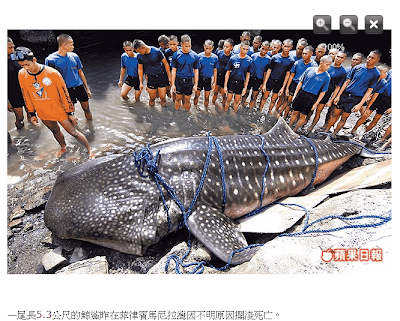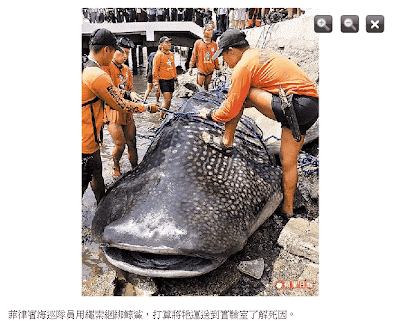離奇 鯨鯊擱淺亡
2009年10月28日 星期三

蘋果日報 20091029
達人語:
海生館前館長、正修科技大學講座教授方力行表示,鯨鯊在馬尼拉灣擱淺死亡是罕見情況。雖然鯨豚擱淺死亡時有所聞,但鯨鯊很少如此,研判可能是生病或受到驚嚇,才會擱淺死亡。
方力行說,鯨鯊是鯊不是鯨,牠是體型最大的魚類,最大可達8公尺、12公噸重,是變溫性動物。因肉嫩質細,又被稱為「豆腐鯊」,過去常被捕殺食用,導至數量銳減,目前已列保育類動物。方力行說,鯨鯊對人友善,他曾與鯨鯊在海中共游過,目前澳洲有相關旅遊行程,可讓遊客近距離觀察鯨鯊。文╱陳威廷˙圖╱法新社、路透
鯨鯊小檔案
菲律賓海巡隊員用繩索綑綁鯨鯊,打算將牠運送到實驗室了解死因。
學名:Rhincodon typus
體型:最大可達8公尺長、12公噸重
分布:全球中緯度以下海域皆可見
特徵:深灰帶點藍色的表皮、身上有白斜條紋與白星點、嘴中有骨板,骨板上分布凹凸不平的細齒
資料來源:方力行
註:新聞中有誤,鯨鯊可達18公尺。
Dead 'butanding' found in Manila Bay
 By Anna Valmero
By Anna ValmeroINQUIRER.net
First Posted 19:25:00 10/28/2009
MANILA, Philippines— A whale shark, locally called “butanding”, was found dead on Manila Bay by local fishermen on Wednesday morning, according to the local arm of conservationist group World Wide Fund for Nature (WWF).
WWF Philippines information officer Gregg Yan said the possible causes for the butanding’s death include disease, gear entanglement, exposure to organic pollutants and ship strikes.
Measuring 15-feet long, the female whale shark bore a few scars, including small cuts on its tail possibly caused by a rope and strange injuries to both eyes, with the eyeballs missing when the carcass was found along the South Harbor at 1:30a.m., said Yan.
Earlier on Wednesday, the Philippine Coast Guard, Bureau of Fisheries and Aquatic Resources (BFAR), Department of Environment and Natural Resources (DENR), Manila Ocean Park and WWF went to the site where the dead whale shark was found to document the carcass.
A necropsy will be conducted to examine its cause of death, while the carcass will be immediately buried in the town of Dagupan in Pangasinan province, where the remains of other large sea creatures are buried.
The whale shark is the third largest marine animal to have died in Manila Bay over the past three years, said Yan. The first two include a dead baleen whale found floating beside a passenger ship moored in Manila Bay on December 2008 and another baleen whale carcass was found floating on August 2007.
Whale sharks can grow up to 40 feet long, with a maw wide enough to swallow a person. However, they feed only on planktons, acting as living filters to improve overall water quality in the seas.
Classified as a vulnerable species or close to being endangered by the International Union for Conservation of Nature in 2000, the global population of whale sharks continues to decrease, said Yan.
14-foot whale shark found dead in Manila Bay, to be buried in Pangasinan
By Evelyn Macairan (The Philippine Star) Updated October 29, 2009 12:00 AM
 MANILA, Philippines - As people troop to cemeteries to honor their dead kin this weekend, officials of the Bureau of Fisheries and Aquatic Resources (BFAR) will visit a graveyard in Pangasinan to bury a two-year-old whale shark.
MANILA, Philippines - As people troop to cemeteries to honor their dead kin this weekend, officials of the Bureau of Fisheries and Aquatic Resources (BFAR) will visit a graveyard in Pangasinan to bury a two-year-old whale shark.Philippine Coast Guard (PCG) commandant Admiral Wilfredo Tamayo yesterday said that the whale shark, locally called butanding, was found floating in Manila Bay by fishermen.
The whale shark (Rhincodon typus) is believed to be only two years old. The average life span of whale sharks is between 10 to 20 years.
Fishermen Melchor Cariño, Benzar Jara and Sadat Jara were on board the M/B Romar when they spotted the creature some 50 miles off the Manila Yacht Club at around 4 a.m. yesterday. At first, they thought it was just a large log floating on the water. They pulled it to the breakwater and called the media and authorities when they found out that it was a butanding.
Tamayo dispatched a rubber boat to tow the 5.2-meter whale shark to their headquarters. “But the whale shark was too heavy for them that they had to call for a second boat for assistance,” he said.
Upon reaching the PCG’s wharf, Tamayo instructed 15 of their draftees to pull the animal to the wharf, but they were no match for the two-ton fish. The PCG tried utilizing the crane from their Marine Environment Protection Command truck, but since its maximum capacity is only one ton, they were apprehensive that the crane would break if they persisted on pulling in the giant fish.
Tamayo instructed the crew of the rubber boat to bring the whale shark to a vessel with a bigger crane docked nearby. Once lifted from the waters, the whale shark would be turned over to BFAR for examination and disposal.
Edwin Alesna, BFAR-Fisheries Quarantine Regulation and Wildlife chief, said they would conduct a necropsy on the whale shark to determine the cause of death.
“We need to examine its belly to know what it ate. The Manila Bay is a polluted area and the pollutant might be a contributing factor,” Alesna said.
Tamayo hinted at the possibility that climate change could have caused the giant fish’s death.
Alesna, however, said that they are still exploring the possibilities. A quick check showed that the whale shark did not bear any serious injury and had only bruises that might have been sustained while it was being dragged.
It was also possible that the whale shark was already feeling ill and decided to stay close to shore.
The Manila Bay area is also teeming with plankton, the whale shark’s food, and the creature may have only wanted to feed.
“They go where the food is,” Alesna said.
The butanding are tropical fishes that are considered endangered species and are often found in Donsol, Sorsogon and in Pamilacan, Bohol. World Wildlife Fund (WWF) information, education and communication officer Gregory Paul Yan said they have so far tracked 280 whale sharks in Donsol.
But there were signs that its migratory patterns are changing. The BFAR official said there were sightings in Atimonan in Quezon province and in Batangas.
“These whale sharks come in groups called pods. So there is a possibility that there would be more sightings of whale sharks in Manila Bay,” he added.



0 意見:
張貼留言